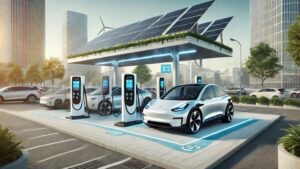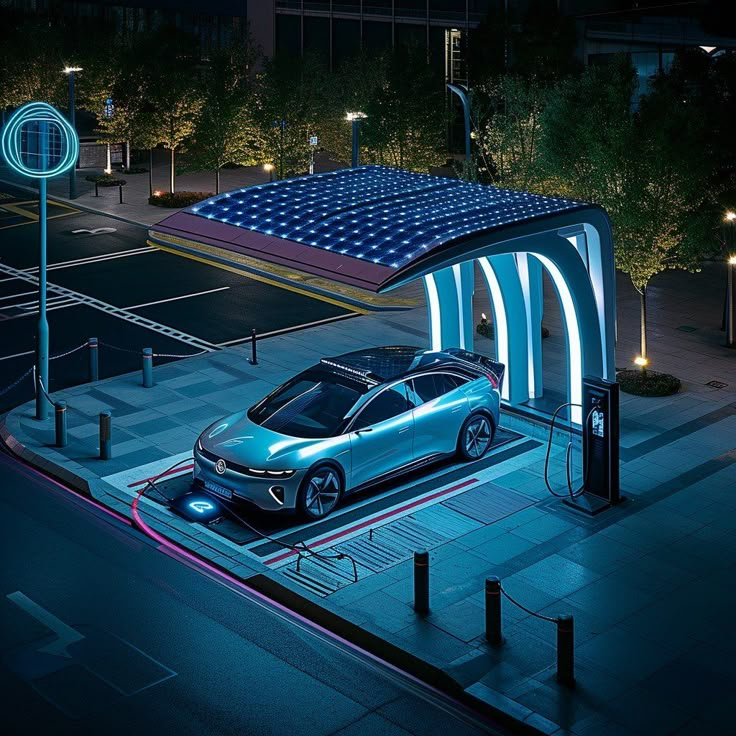## 🌞 **Integration of Solar Energy: A Source of Clean Energy for Electric Vehicles**

💨 **Role of Wind Energy: Ensuring a Continuous Energy Supply for Electric Vehicles**
Wind energy has played a significant role in providing a constant and reliable energy supply for the electric vehicle charging network. Offshore wind farms have generated large-scale clean energy, providing sustainable charging solutions for electric vehicles in coastal areas. Vertical axis wind turbines have made the use of wind energy possible in urban areas. Airborne wind energy systems have harnessed high-altitude winds to achieve greater efficiency than traditional turbines. Small-scale wind turbines have promoted decentralized energy production. Hybrid wind-solar systems have combined both renewable sources to ensure a continuous energy supply. Smart wind forecasting has provided accurate information to grid operators, improving energy management. Wind-powered hydrogen production has created a new source of energy storage. Floating wind turbines have enabled the exploitation of wind energy in deep waters. Wind energy microgrids have provided sustainable transportation solutions for remote communities. All these initiatives are making wind energy a vital part of the sustainable future of electric vehicles.
🌊 **Contribution of Hydropower: A Stable Energy Source for Electric Vehicles**
Hydropower has provided a stable and reliable energy source for electric vehicle charging infrastructure. Small-scale hydroelectric projects have generated clean energy at the local level, providing sustainable charging options for electric vehicle users. Pumped storage hydropower has stored excess renewable energy for use during peak demand periods. Run-of-river hydroelectric systems have generated energy while maintaining the natural flow of rivers. Hydrokinetic turbines have introduced a new method of directly obtaining energy from river currents. Floating hydropower plants have generated energy without the use of water reservoirs. Hydropower microgrids have enabled the use of electric vehicles in remote areas. Smart hydropower management has ensured the efficient use of water resources. Hydropower-energy storage integration has increased grid stability. Environmental flow releases have ensured the protection of aquatic ecosystems. All these developments are making hydropower a key pillar of the sustainable future of electric vehicles.
♻️ **Biomass Energy: A Carbon-Neutral Solution for Electric Vehicles**
Biomass energy has presented a carbon-neutral solution for electric vehicle charging systems. Waste-to-energy plants have converted municipal solid waste into a valuable energy resource, reducing landfill waste. Agricultural residue biomass has created an additional source of income for farmers. Algae-based biofuels have opened a new path for energy production on non-arable land. Biogas plants have generated clean energy from animal waste. Biomass gasification has converted solid biomass into synthetic gas, creating a versatile energy carrier. Bioenergy with carbon capture has introduced the concept of negative emissions technology. Biomass co-firing has increased the share of renewable energy in existing power plants. Decentralized biomass systems have enabled the use of electric vehicles in rural areas. Sustainable biomass sourcing has reduced the risks of deforestation. All these initiatives are making biomass energy an important part of the sustainable future of electric vehicles.
🌋 **Geothermal Energy: A Constant Energy Source for Electric Vehicles**
Geothermal energy has provided a constant base load power source for the electric vehicle charging network. Enhanced geothermal systems have expanded the scope of traditional geothermal resources. Binary cycle power plants have converted low-temperature geothermal resources into usable energy. Geothermal heat pumps have provided an efficient solution for both heating and cooling. Direct use applications have enabled the use of geothermal energy in industrial processes. Geothermal microgrids have provided sustainable transportation solutions in geothermal-rich regions. Hybrid geothermal-solar systems have increased the reliability of energy production. Geothermal energy storage has ensured efficient management of excess energy. Environmental monitoring systems have kept track of the environmental impacts of geothermal operations. Community engagement programs have protected the interests of local populations. All these developments are making geothermal energy an important part of the sustainable future of electric vehicles.
🌊 **Marine Energy: Utilizing Untapped Resources for Electric Vehicles**
Marine energy has provided a vast and untapped energy source for electric vehicle charging infrastructure. Tidal stream generators have converted the kinetic energy of ocean currents into electrical energy. Wave energy converters have introduced new methods of harnessing the power of ocean waves. Ocean thermal energy conversion has generated energy from the temperature difference in the ocean. Salinity gradient power has produced energy from the difference in salinity between river and sea water. Offshore energy islands have combined multiple marine energy sources to increase efficiency. Marine energy microgrids have provided sustainable transportation solutions for coastal communities. Environmental impact assessments have ensured the protection of marine ecosystems. Advanced materials have extended the life of devices in corrosive marine environments. Predictive maintenance systems have increased the reliability of offshore operations. All these developments are making marine energy an important part of the sustainable future of electric vehicles.
🔋 **Energy Storage Systems: Facilitating the Integration of Renewable Energy**
Energy storage systems have played a key role in the smooth integration of renewable energy into the electric vehicle charging network. Grid-scale battery storage has stored excess renewable energy for use during demand peaks. Pumped hydro storage has provided large-scale energy storage facilities. Compressed air energy storage has introduced an efficient method of storing energy in underground caverns. Flywheel energy storage has provided a high-power solution for short-term energy storage. Thermal energy storage has established a system for storing excess energy as heat. Hydrogen energy storage has presented a solution for long-term seasonal energy storage. Vehicle-to-grid technology has transformed electric vehicles into mobile energy storage units. Smart energy management systems have established a better balance between storage and demand. Decentralized storage solutions have made energy independence possible for individual consumers. All these developments are making energy storage systems an important part of the sustainable future of electric vehicles.
📊 **Intelligent Grid: A Means for Smooth Integration of Renewable Energy**
Intelligent grid systems have enabled the smooth integration of renewable energy into the electric vehicle charging network. Smart meters have provided real-time energy consumption monitoring. Demand response programs have managed energy consumption during peak demand periods. Distributed energy resources management has ensured the efficient integration of decentralized energy production. Grid automation systems have automatically detected and responded to faults. Predictive analytics have enabled preventive measures by predicting grid performance. Cybersecurity measures have ensured the protection of grid operations. Microgrid controllers have provided localized grid management facilities. Blockchain technology has enabled peer-to-peer energy trading. Grid resilience planning has increased the grid’s resistance to extreme weather events. All these developments are making intelligent grid systems an important part of the sustainable future of electric vehicles.
🌍 **Policy and Strategy: Promoting the Integration of Renewable Energy**
Policies and strategies have played a key role in promoting the integration of renewable energy into electric vehicle charging infrastructure. Renewable portfolio standards have imposed renewable energy production targets on utilities. Feed-in tariffs have provided guaranteed prices to renewable energy producers. Tax incentives have promoted investment in renewable energy projects. Carbon pricing mechanisms have made renewables competitive by increasing the relative cost of fossil fuels. Research and development funding has assisted in the development of new renewable technologies. Grid interconnection standards have simplified the procedures for connecting renewable energy systems to the grid. Community energy policies have promoted local renewable energy projects. International cooperation agreements have accelerated global renewable energy deployment. Environmental regulations have formed legal frameworks for renewable energy adoption. All these initiatives are making policies and strategies an important part of the sustainable future of electric vehicles.
🔮 **Future Trends: The Continuous Evolution of Renewable Energy**
Future trends indicate the continuous evolution of the integration of renewable energy into electric vehicle charging infrastructure. Floating solar-wind hybrid systems have opened new opportunities for offshore renewable energy production. Artificial intelligence optimization has increased the performance of renewable energy systems. Space-based solar power has created the possibility of overcoming ground-based limitations. Bio-inspired energy systems have increased efficiency by learning from nature. Quantum dot solar cells have revolutionized efficiency through the use of new materials. Ocean energy arrays have paved the way for large-scale marine energy production. Geothermal supercritical systems have accessed ultra-high temperature resources. Hydrogen-based energy storage has solved long-duration storage challenges. Smart city integration has enabled comprehensive optimization of urban energy systems. Global energy interconnection has presented the concept of worldwide renewable energy sharing. All these future trends are making renewable energy an important part of the sustainable future of electric vehicles.


